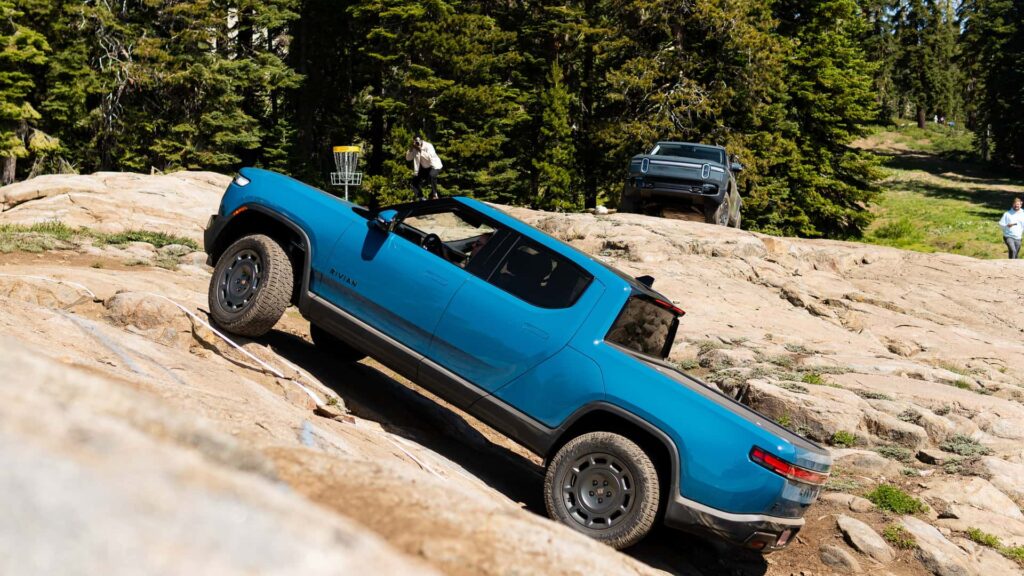The Rivian R1T and R1S Quads are undeniably impressive vehicles, with over 1,000 horsepower and exceptional off-road capabilities. These electric vehicles are equipped with a quad-motor setup, making them versatile for various terrains and driving conditions. However, for enthusiasts who prioritize simplicity and control in their off-road adventures, a more traditional solution may be preferred.
In a recent rock crawling review by TFLEV, the R1T was put through its paces on a challenging terrain near Lake Tahoe, California. The video showcased the vehicle’s performance on slippery rocks, highlighting its capabilities and limitations. One key drawback of a quad-motor EV powertrain is the increased wheel slip compared to vehicles with locking differentials.
Locking differentials are components that ensure equal power distribution to all wheels, regardless of the terrain. This results in better traction and control, especially in challenging off-road conditions. In contrast, a quad-motor setup requires software control to manage power distribution, leading to instances of wheel slip and the need for adjustments to maintain traction.
The R1T’s performance on the rock-crawling course demonstrated the complexities of managing power delivery with four independent motors. While the vehicle ultimately conquered the terrain, some enthusiasts may prefer the simplicity and reliability of locking differentials for hardcore off-road use.
Despite its drawbacks, the quad-motor setup in the R1T and R1S offers torque-vectoring capabilities on the road and enhances the overall driving experience. These vehicles excel in providing exceptional performance both on- and off-road, thanks to their advanced technology and engineering.
For enthusiasts who prioritize off-road performance above all else, vehicles with locking differentials remain the preferred choice. The upcoming launch of Scout’s electric truck with front and rear lockers has generated excitement among off-road enthusiasts, who are eager to see how it compares to the quad-motor setup in the Rivian vehicles.
In conclusion, while the Rivian R1T and R1S Quads offer impressive performance and versatility, traditional locking differentials still hold appeal for hardcore off-road enthusiasts. The choice between a quad-motor setup and locking differentials ultimately comes down to individual preferences and priorities in off-road driving experiences. Rivian has been making waves in the electric vehicle market with their innovative designs and impressive performance capabilities. One of their latest offerings, the Rivian Quad Motor, is set to take on both on and off-road terrain with ease.
Many enthusiasts believe that the Quad Motor will excel in off-road conditions, thanks to its four-wheel drive system and lockers. This setup should provide superior traction and stability when tackling rugged terrain, making it a top choice for adventure seekers and outdoor enthusiasts. However, some skeptics suggest that the Quad Motor may sacrifice speed and agility on the road in favor of its off-road capabilities.
To settle this debate once and for all, a comparison test will need to be conducted. This test will pit the Rivian Quad Motor against other vehicles in its class to determine how it performs both on and off-road. By putting the Quad Motor through its paces in a variety of driving conditions, we can get a better understanding of its strengths and weaknesses.
For those interested in learning more about the Rivian Quad Motor and its performance capabilities, be sure to stay tuned for the results of the upcoming comparison test. In the meantime, feel free to reach out to the author, Mack Hogan, at Mack.Hogan@insideevs.com for any further inquiries or information.
Overall, the Rivian Quad Motor is shaping up to be a versatile and capable vehicle that is sure to impress both on and off-road enthusiasts. Keep an eye out for more updates on this exciting new model from Rivian.

